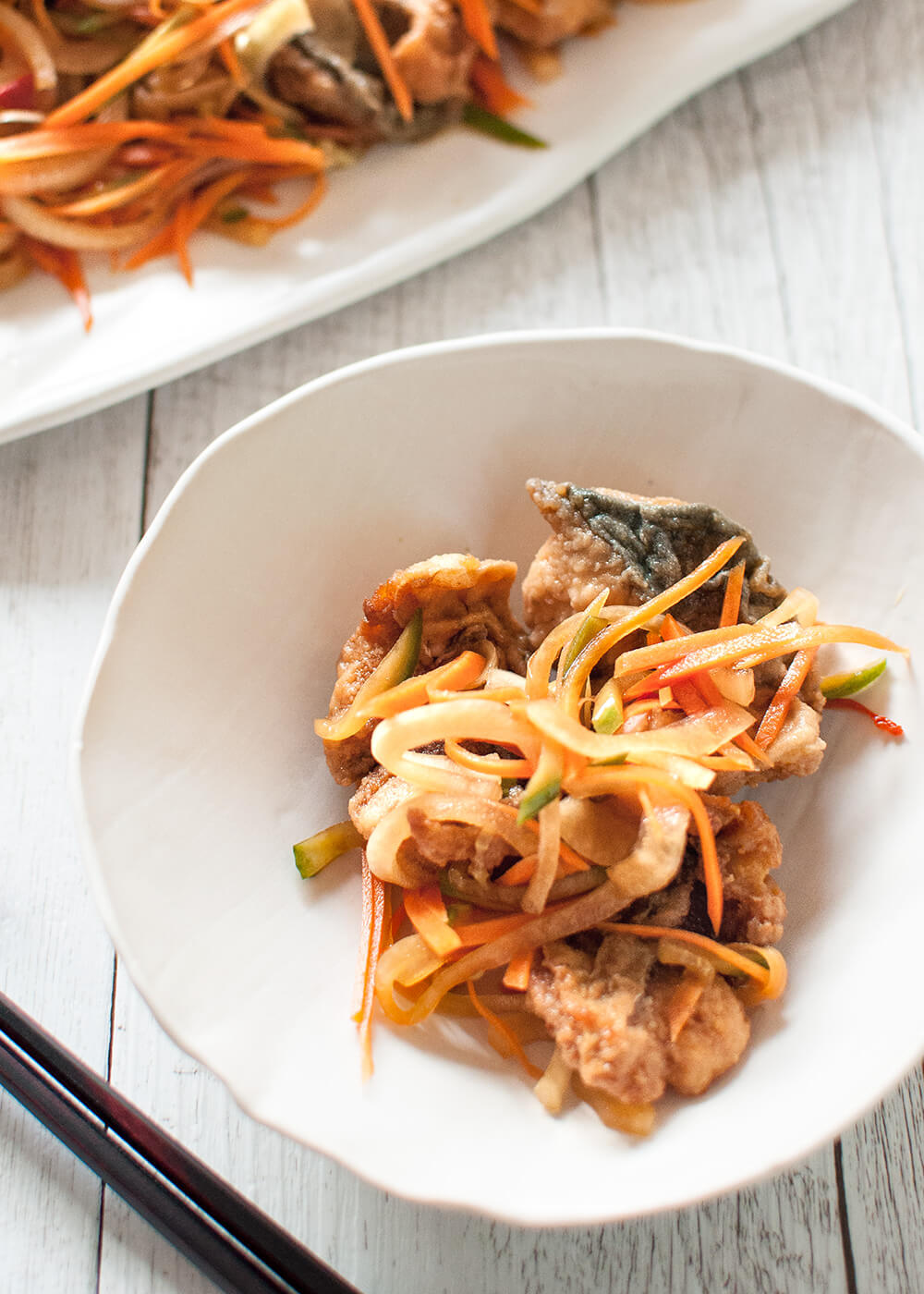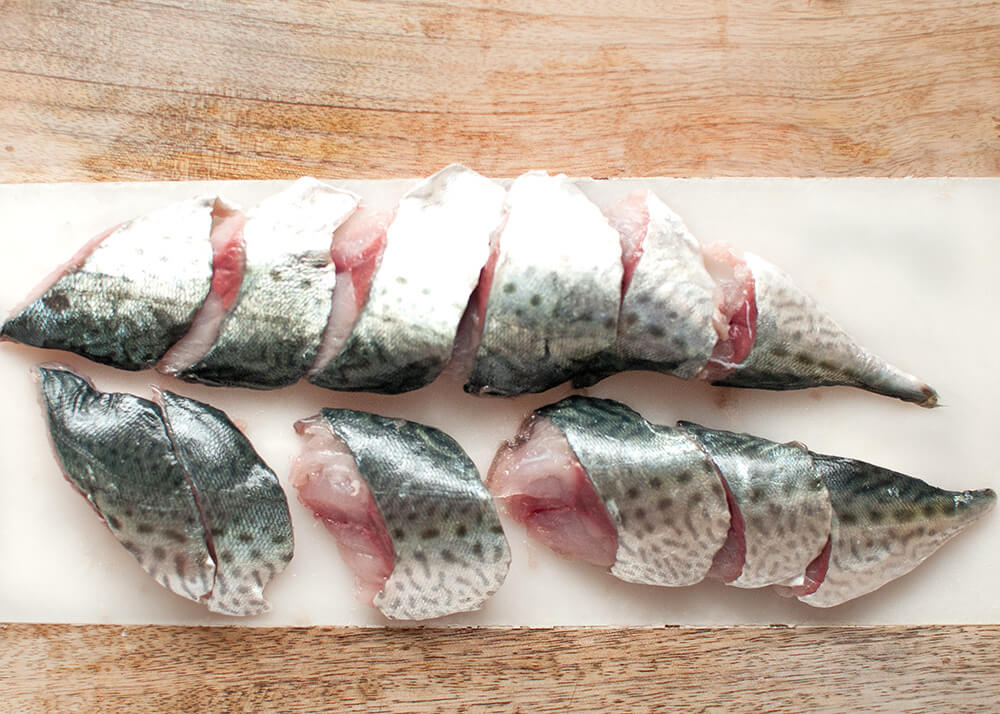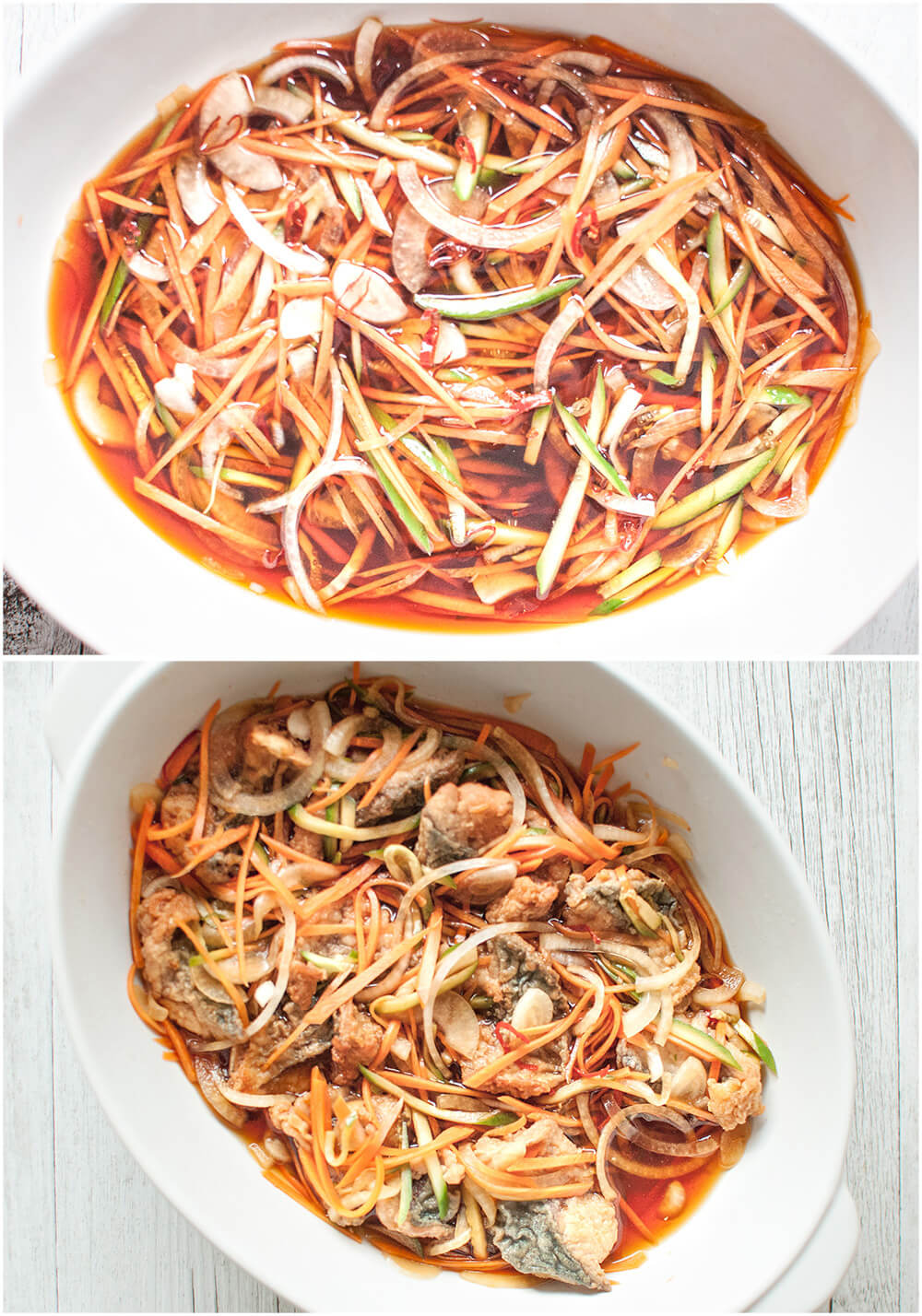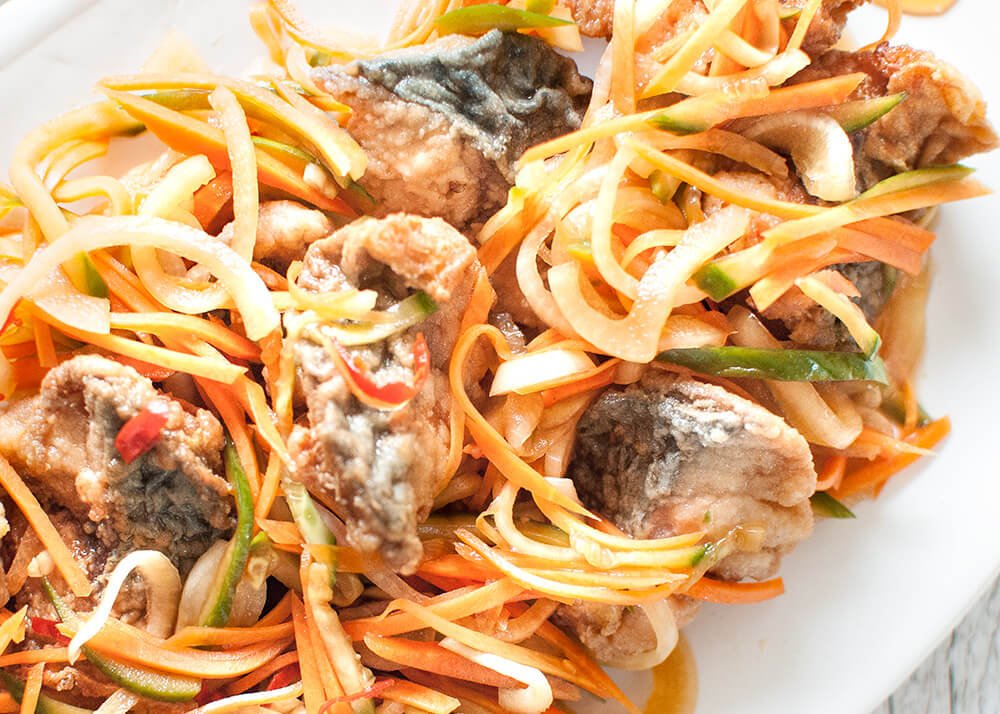When bite size pieces of deep fried fish are marinated in slightly sweet vinegar and soy based sauce with plenty of shredded vegetables, it transforms the fish into something totally different. Nanbanzuke (Marinated Fried Fish) keeps well in the fridge and is usually served cold or at room temperature. Perfect in hot summer and for lunch boxes.

Nanbanzuke (南蛮漬け) is almost like a Japanese version of escabeche which is common in the Spanish-speaking world, Portugal and France. In the 16th century, the Portugese and Spanish travelled to Japan via south east Asia and trading between Japan and these countries started. The Japanese called their culture “nanban” (南蛮) and people “nanbanjin” (南蛮人).
Because this dish is similar to escabeche and the ingredients include chilli and onions, the dish is called nanbanzuke. The word “zuke” (漬け) means marinate.
Although some recipes call for chicken to marinate, the standard nabanzuke is a fish dish.

ABOUT FISH
Typical nabanzuke uses small yellowtail (horse mackerel), dusted with flour and deep fried whole. After marinating it in the vinegar marinade overnight or for 24 hours, the bones of the fish become so tender that you can eat them all including the heads.
The other popular small fish in Japan suited for nanbanzuke is smelt (ワカサギ , “wakasagi” in Japanese) which is a white small fish and has sandy coloured skin with a white belly. But I cannot buy it here in Sydney. The fish shop that I always go to does not usually sell small yellowtail of about 8-10cm (3-4”) long, either.
So, I usually buy a large yellowtail, fillet it and cut the fillets into bite size pieces to marinate. Other fish can also be marinated as long as the fish is good to deep fry, e.g. slimy mackerel (blue mackerel), king fish, whiting etc.
Today, I used a slimy mackerel as the fish was very fresh and I like mackerel a lot. I bought a whole fish and asked the shop to fillet it. There are bones running in the middle of the fillet lengthwise so you have to remove all of them with fish bone tweezers. If you run your finger along the lateral line, you will feel the bones. After removing the bones, diagonally slice the fillet into bite size pieces. See the photo below.

Because you will be deep frying the fish, it is better to have fillets with the skin on so that the meat will not easily break.
ABOUT VEGETABLES
Typical vegetables to be marinated with the fish are carrots, onions, and cucumbers. Some recipes use capsicums and shallots (scallions) but the majority of the recipes out there on Japanese websites use carrots, cucumbers and onions. And I am not the exception.
You must also add red chilli to the marinade otherwise it is not called “nanban”. Actually the marinade described in the next section with these vegetables and chilli is called “nanban-zu” (南蛮酢) meaning nanban-style vinegar.
As you can see in the photos, nanbanzuke is a colourful dish mainly because of the choice of vegetables.

NANBANZUKE MARINADE
The marinade is a mixture of vinegar, soy sauce, dashi stock (or water), sake, mirin and sugar. I prefer using dashi stock rather than just water as it gives umami to the marinade. It is also a must to add dried red chilli (whole chilli chopped into smaller pieces).
It is important to place the fish in this marinade immediately after the fish is fried, while still very hot. This will allow the fish to absorb the marinade well. So, the marinade needs to be made before the fish is to be fried.
You can use this marinade to make vegetarian nanbanzuke by frying sliced or julienned vegetables instead of fish. Use konbu dashi or water to make the marinade.

I like sunomono (酢の物, vinegared dishes) and nanbanzuke is one of my favourites. It keeps about a week in the fridge so I make it for 3-4 people and keep on eating it directly from the fridge, even just as nibbles.
Yumiko![]()

Total Time does not include time to marinate.
- 60 g (2.1oz) carrot julienned into 2mm (1/16") thick, 5 cm long pieces (note 1)
- 60 g (2.1oz) cucumber julienned into 3mm (⅛") thick, 5cm long pieces (note 1)
- 90 g (3.2oz) onion, cut into half then thinly sliced 2mm (1/16") thick crosswise
- 1 dried red chilli deseeded , finely chopped (note 2)
- 250 g (0.5lb) mackerel fillet, cut into large bite size pieces (note 3)
- 1 tbsp flour
- Oil to fry fish
- 3 tbsp dashi stock
- 3 tbsp soy sauce
- 3 tbsp rice wine vinegar
- 2 tbsp sake
- 1 tbsp mirin
- 1½ tbsp sugar
-
Put marinade ingredients in a bowl and mix well until sugar is dissolved.
-
Put carrot, cucumber and onion into a large deep plate or a non-metal baking dish and add the marinade mixture. Mix vegetables well.
-
Heat oil in a small saucepan (note 4) to 170-180C (338-356F). The depth of the oil should be twice as deep as the thickness of the fish.
-
Place fish pieces into a small bowl, add flour and toss to coat the fish with flour evenly. Shake off excess flour.
-
Drop each fish piece one by one into the oil and fry them for 1.5 – 2 minutes until the fish becomes golden brown and cooked through. Cook few pieces at a time. (note 5)
-
Remove the fish onto a paper towel lined plate to drain oil for 5-10 seconds, then place it straight into the marinade while still hot. Repeat with the remaining fish pieces.
-
Turn the fish fillets over to coat them with marinade and cover them with some vegetables.
-
Marinate for minimum 15 minutes, preferably overnight in the fridge.
-
Serve cold or at room temperature.
1. I usually slice them diagonally into 5cm long ovals, then julienne them. This method is particularly good for cucumbers as the green part comes on both ends of the stick for every piece.
2. I find that chopping dried chilli into round pieces using a knife is difficult as the dry skin tends to break. I use a pair of kitchen scissors which works well.
You can use fresh chilli if you like. If you are sensitive to hot chilli, omit it.
3. You don’t need to use mackerel fillet. I sometimes buy yellow tail as they are usually quite cheap. You can use other fish fillets such as Spanish mackerel, king fish, or any white flesh fish suitable for deep frying.
In the case of mackerel/yellowtail, I cut the fillet diagonally to show more flesh on the surface. The width of the skin is 2.5-3cm (1-1¼”). This will penetrate more flavours into the fish pieces. But you can just cut it straight down into bite size pieces if you like.
4. I suggest that you use a small saucepan so that you don’t need to use a lot of oil. My saucepan was 16cm (6¼”) in diameter. But if you don’t mind using a large quantity of oil, use a large fry pan. Then you will be able to fry more pieces at once.
5. Please do not fry too many pieces at once as the temperature of the oil drops too much and you won’t be able to make crispy fried fish. I fried a few pieces at a time in my small saucepan.
Thanks for this recipe Yumiko. We had fish last night but will definitely try this recipe when next we have fish.